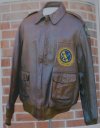Jennison
Well-Known Member
I was on the Good Wear site reading about the
A-1 jacket. They became non-standard in May, 1931 with the advent of the A-2. No surprise there. What confuses me however, is the statement that the A-1 stock was “finally exhausted during WWII.” What exactly does that mean in light of the A-1’s non-standard classification a decade earlier? Could Air Corps personnel wear A-1 jackets as long as they were available? If so, are there extant WWII period photos of A-1s in service?
A-1 jacket. They became non-standard in May, 1931 with the advent of the A-2. No surprise there. What confuses me however, is the statement that the A-1 stock was “finally exhausted during WWII.” What exactly does that mean in light of the A-1’s non-standard classification a decade earlier? Could Air Corps personnel wear A-1 jackets as long as they were available? If so, are there extant WWII period photos of A-1s in service?

